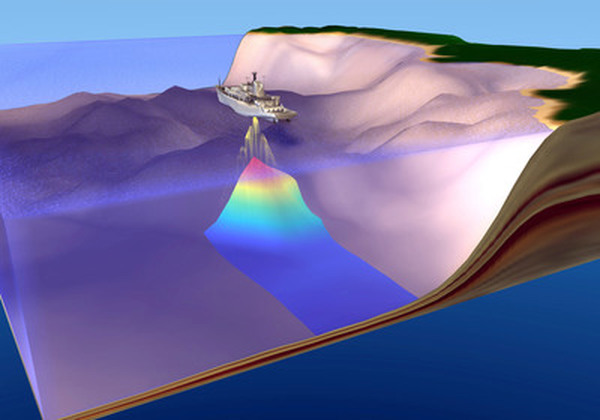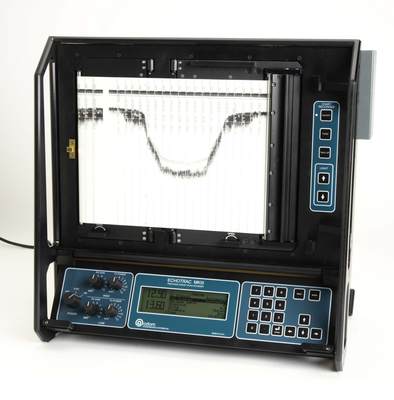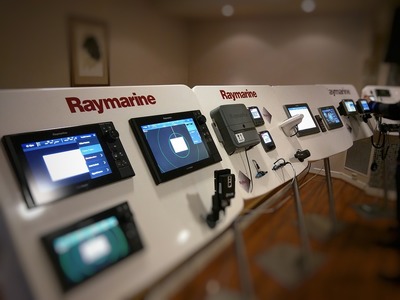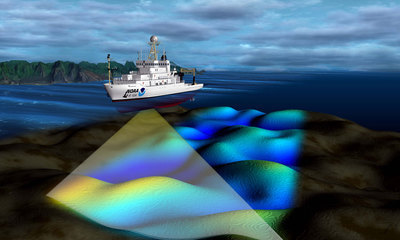
View all banners
FAFB will never call you and ask for your credit card details over the phone. If this happens, hang up!


Depth sounders (or echo sounders) are a type of SONAR system used in marine navigation to determine the depth of the water or to locate and visualize objects beneath the waves. They are used as both a navigational and charting aid as well as to help commercial fishing vessels to find fish.(fishfinder)They are also used by marine scientists to aid their research.

Quite simply, depth sounders transmit a pulse into the water and measures the rate at which this sound is returned from any solid object it tries to pass through between the transducer and the ocean floor. Depending upon the sophistication of the technology installed, the receiving device will then translate this data into a range of outputs from either basic depth measurements or into three-dimensional images.
The basic technology, also known as hydroacoustics, has been in existence since as early as 1906 when Lewis Nixon invented the first underwater sonar device to help ships locate icebergs. Advances continued during both World Wars and continue to be developed in the 21st century providing a ships crew with very powerful navigational and commercial information.
There are several key elements to an echo sounder and it’s important to understand these basics to enable you to choose the right device for your application.
It’s important to understand the difference between reading an echo/depth sounder and interpreting the data received to help locate fish. A basic echo sounder will return imagery based on static objects whereas a sounder which is designed to aid fishermen will also reflect back from any object that is denser than the surrounding water, including rocks, metal and mud but also the air filled bladders of fish. Fish that do not have swim bladders such as sharks and rays therefore do not show up on fish finding devices.
Most current applications of fish finding technology show clear and resolute data allowing you to identify single or shoals of fish but some of the older designs require additional interpretation. Each manufacturer varies in design but the visual representation of fish vs plankton or solid objects is relatively easy to determine as the size, composition and position of them moves in the water.
There are several key elements to an echo sounder and it’s important to understand these basics to enable you to choose the right device for your application.
The frequency of the transducer is a crucial factor in the depth of your range but also the level of information provided. Typically the lower the frequency the more practical for deeper waters (something like a 50kHz wave will penetrate further whereas 200kHz is more suitable for shallow waters). However, the benefit of the higher frequency is that the detail of the imaging returned is much greater than that of the lower ranges. Some devices offer dual or multiple frequencies which provide both range and clarity.
As well as the frequency of the transducer it is important to ensure that the device is installed in the best location to get the best results.
As important as the transducer itself, the power of your device will determine the speed at which information is transmitted. A low power device will take longer to return accurate information by which point any advantage of having it installed may have been lost. This is also relative to the depth of water you are using it in. Generally speaking you will need lower power at higher frequency for shallower waters and higher power, lower frequency for deeper waters.
This term refers to the width of the beam that the transducer is sending to the floor of the body of water you are in and a narrow beam will cover less area than a wider beam. More advanced echo sounders have multiple beams including side beams which give greater coverage.

Whilst all echo sounders fundamentally do the same job the additional functionality and features vary enormously so it’s worth considering what is important to you in your output before choosing a device. Screen display size, resolution, extra features such as SD card outputs, GPS navigation, photographic imagery are all available but will affect the price though a suitable depth sounder on a budget is not hard to find.
Any fishing boat can be fitted with a sounder but how do you choose which one?

Depending upon what the primary aim is for your echo sounder there are a wide range of devices available, the features of which vary according to the price. For many commercial fishermen, the primary use of an echo sounder will be to find fish. Garmin’s latest fish finder, the Echo 551DV, produces a dual beam transducer that can reach depths of 2300ft. The returning data is translated into a full colour display across a 5” screen as well as providing a near photographic image beneath the boat. Prices start at around £300 and the device comes with several other features including zoom, panning and split screen mode. The Lowrance Elite 7x and Raymarine Dragonfly fishfinder also come out highly across peer review sites.
If you are looking to more functionality from your echo sounder then there are products available which combine modes such as GPS or other navigational and charting features such as the Hummingbird 859ci HD GPS/Sonar combo. This powerful 4kW sounder comes with GPS and SD cards input for storing cartography or photographic images obtained from the device. Prices for this device start at around £450. The above mentioned devices are mostly fixed installations but there are portable fish finding devices available which allow greater flexibility for those fishermen who lease and have access to different boats. Hummingbird’s 140C Fishin’ Buddy is a lightweight and portable device secured to an extendable pole meaning you can use the sounder from most small and mid-sized vessels as well as from dockside. The range of the sound wave extends to around 250ft making it less powerful than a fixed option but a useful tool nevertheless.
By and large, prices for echo sounders as fish finders will vary depending on the power output, screen resolution and size plus added functionality but there are a great many affordable options on the market including Simrad, Ikon, Foruno, Koden and JRC. Most of these can be purchased direct from Electrotech Marine.
If you are looking for a depth sounder with the primary aim of aiding navigation and charting then the range of devices is also varied. A basic sounder with a backlit LCD screen providing depth measurements only can be as little as £100 but if you require greater quality of information, or fish in deeper waters, then this can significantly increase the cost.
Before making a purchase it’s best to know in advance what features are a must-have so that the device suits your intended purpose and that it will be powerful enough to provide adequate information based on the depth and type of the waters you are navigating. For instance the Garmin Echo 100 is an entry model with a black and white display, it’s single beam sonar, low power and high frequency makes it a suitable choice for freshwater fishing in depths of no more than 600ft whereas a low frequency, higher power multiple beam system such as Lowrance Elite-5X HDI is more suited to deeper water.
FAFB has a great range of new and used depth and echo sounders available through our adverts